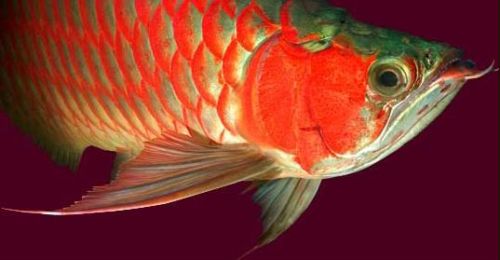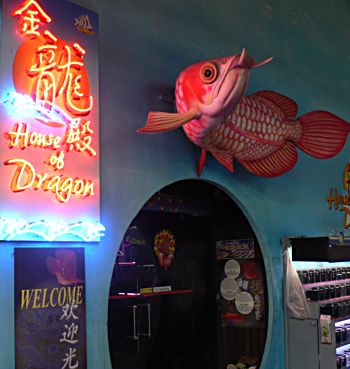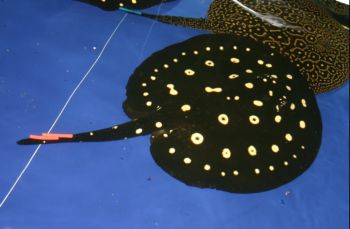 Buyers of Qian Hu dragon fish can obtain its code and verify the authencity of the fish variety on Qian Hu's website. Photo: Qian Hu
Buyers of Qian Hu dragon fish can obtain its code and verify the authencity of the fish variety on Qian Hu's website. Photo: Qian Hu
Section of Qian Hu farm specialising in the display of dragon fish. Photo by Leong Chan Teik
Singapore-listed Qian Hu sells millions of dollars worth of dragon fish annually all over the world, particularly to China.
Each year, the group produces a third, or about 10,000, of the world's supply.
Much of its efforts to boost the sale of dragon fish will be centred on Batu Pahat, Johor, where it owns a 65% stake in a Malaysian subsidiary, Kim Kang Aquaculture Sdn Bhd.
Since 2006, the dragon fish farm has been expanding through the acquisition of new land and the building of new ponds for breeding. The expansion ends this year.
In the first nine months of this year, Qian Hu bought $5.4 million of brooder stocks for the Johor farm. Brooders cost $5,000-$10,000 each, depending on the variety, when they are sexually mature at six or seven years old.
“We have lots of space now in our Johor farm. It’s huge - about 5X that of the Singapore one. We have 200-300 ponds there, compared to 19 now in Singapore, said Kenny Yap, executive chairman of Qian Hu, in an interview with NextInsight.
The Johor farm focuses on breeding, while the 4.2 hectare Singapore farm hosts an integrated operation bustling with activities related to administration, and exporting fish and accessories, and retailing – and breeding dragon fish.

These stingray varieties are being bred in Qian Hu's farm in Batu Pahat. Photo: Qian Hu
In Batu Pahat, it’s not just dragon fish but also other high-value fish such as stingray (originally from South America) that the farm breeds. Stingray is a new species to be bred by the farm as the company recognizes a growing popularity of colorful freshwater stingray in recent years.
Freshwater stingrays tend to be smaller than the saltwater wild variety, and cost between $300 and $2,000 each.
But stingray, whose sting can cause severe injury and even death, is not expected to become as big a business as dragon fish, said Kenny.
A key reason is the supply of stingray is still limited as its breeding techniques are still in their infancy, unlike dragon fish which are being bred with increasing success.
The dragon fish’s popularity is entrenched among hobbyists for its resemblance to dragons and it being a symbol of prosperity and good luck.
Amazingly, Kenny said that dragon fish can be sold as a branded item. Given Qian Hu’s reputation, buyers trust that the fish varieties are what they are claimed to be. When small, dragon fish may be difficult to differentiate in terms of variety.
Qian Hu’s dragon fish are sold embedded RFID chips with a code number assigned to each fish which can be read with a scanner.

Kenny Yap: Qian Hu farm in Johor is now 5X the size of Singapore farm. Photo by Sim Kih
By keying in the code on Qian Hu’s website, the buyer can know the variety of the fish and verify that it originated from Qian Hu. Qian Hu was one of the first fish farms to adopt the technology.
Next year, Qian Hu may go even further by pioneering the issue of “DNA certificates”, a move that has become possible from its years of R&D to identify the DNA markers that stand for the fish variety and sex.
Qian Hu is pioneering research on other breeding methods, including in-vitro fertilisation of frozen fish sperm and eggs under a research programme with Temasek Life Sciences.
Heading the programme is Alex Chang, a former Ngee Ann Polytechnic lecturer, who has for some years been researching on dragon fish while at Temasek Life Sciences Laboratory and in collaboration with Qian Hu.
He joined Qian Hu last month (Nov) as head of its new R&D department, and will complete his PhD in Life Sciences at the National University of Singapore early next year.
When it comes to breeding fish, Qian Hu focuses on the dragon fish and a few high-value fish such as Arapiama. For other fishes, it will buy from other breeders.

Alex Chang spearheads R&D in dragon fish breeding at Qian Hu.
And that’s how, Qian Hu has been able to rack up $19.7 million in sales in Singapore in the first 9 months of this year, followed by ‘other Asian countries’ ($29.1 million). Europe was next with $14.9 million.
That’s about $7 million worth of fish and accessories sold a month, which goes to prove that Qian Hu has evolved dramatically to the top of the food chain which comprises a lot of smaller fries.
Recent story: QIAN HU: Eyeing nascent Indian ornamental fish market
The Straits Times carried a report in October 2008 on Qian Hu’s breakthrough in R&D of dragon fish breeding. Click here.







